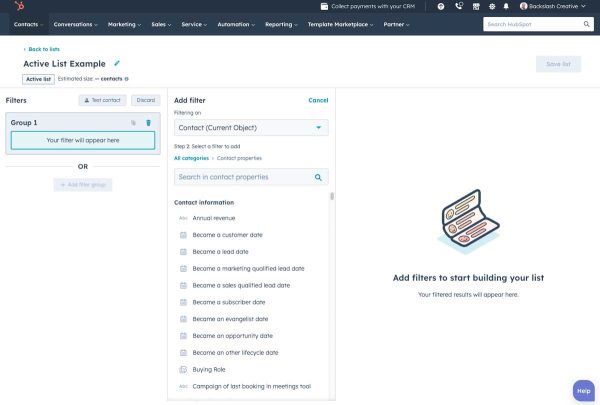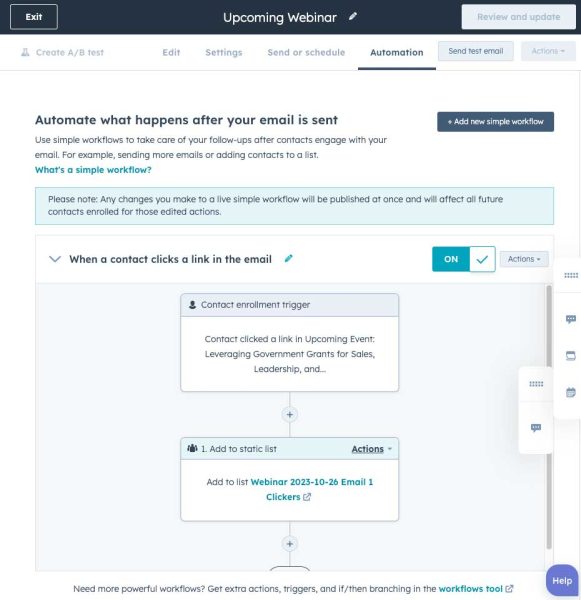Whether you’re new to HubSpot or an experienced user, you’re likely familiar with the concepts of lists. However, even HubSpot veterans don’t always know when to use an active list versus a static list in the powerful marketing automation tool.
It can be more than just a minor difference. Understanding the difference can make strategic marketing automation work much more smoothly! Let’s look at both types of lists, the pros and cons of each, and then look at a couple of real-world scenarios.

Understanding HubSpot’s list functionality
The real advantage of HubSpot’s lists is segmentation. Instead of treating your audience like they’re all the same, segmentation through HubSpot’s lists allows you to tailor your messaging based on various criteria. This can be as simple as separating new subscribers from long-time ones or as intricate as segmenting based on behavioral triggers or contact attributes.
When you segment your lists, you’re essentially sending out emails that are significantly more relevant to the recipients. This relevance is what drives higher open rates and click-through rates. People are naturally more inclined to interact with emails that resonate with their interests or current stage in the customer journey. For instance, a new subscriber might appreciate a warm welcome email with an introductory offer, while a customer who has made a purchase may respond better to a follow-up email with related product recommendations.
Furthermore, segmentation via HubSpot’s lists facilitates better analysis and optimization. By analyzing the performance of different segments, you can gain insight into what resonates with different parts of your audience and continuously optimize your email strategy for better results.
The list functionality is all about making it about your contacts, communicating how they want to communicate, about topics that interest them, and making it as easy as possible for them to take the next step.

What is a HubSpot static list?
Static lists in HubSpot are fixed and do not change unless manually updated. They capture a snapshot of contacts based on set criteria at a specific moment in time. Simply give them a name, then you can start adding contacts to them.
Here are some examples.
Event attendee lists
- Contacts who registered for a webinar.
- Attendees of a live or online event you hosted.
- People you met at a specific networking event.
Campaign-specific lists
- Contacts who responded to a particular campaign.
- Leads generated from a specific landing page.
- Contacts who downloaded a specific whitepaper.
Manual segmentation lists
- A list of contacts handpicked for a specific outreach.
- A list of high-value clients for account-based marketing.
- Clients who have purchased a specific service from you.
Static lists are invaluable for one-off campaigns, historical data analysis, or when a fixed list of contacts is needed for a particular initiative. They allow for a more controlled approach, where you can precisely define who gets included in the list at that moment.
Both active and static lists serve essential purposes within HubSpot’s ecosystem, enabling more strategic and effective engagement with your audience based on varying needs and campaigns.
What is a HubSpot active list?
On the flip side, active lists in HubSpot are dynamic and continuously updated based on the criteria you set. They are crucial for real-time segmentation and engagement. After you give them a name, you have to add filters for contacts to show up in the list.
Here are some examples.
Behavior-triggered lists
- Visitors who viewed a particular page or series of pages.
- Contacts who opened an email or clicked a particular link.
- Subscribers who clicked on a registration link that leads to a HubSpot form, but then did not fill out the form.
Demographic- and psychographic-based lists
- Contacts from a specific geographic location.
- Leads from a particular industry or company size.
- Clients with a specific DISC style.
Lifecycle stage lists
- New subscribers who have just joined your email list.
- Customers who made a purchase within the last 30 days.
- Clients who are approaching the end of a 12-month agreement.
Active lists are ideal for ongoing engagement, where real-time data and actions are critical. They facilitate a more personalized, timely interaction with your contacts, aiding in nurturing leads through the buyer’s journey. The dynamic nature of active lists allows for automatic updates, ensuring that your segments remain relevant and actionable.
Pros and cons of active vs static lists

As you might expect, it’s not always clear-cut which type of list you should use. Let’s look at some pros and cons of each.
Active list pros
- Automatically updated based on set criteria, ensuring real-time accuracy.
- Ideal for ongoing campaigns or long-term engagement strategies.
- Flexibility to change criteria as marketing strategies evolve.
Active list cons
- Might become too large or unmanageable if criteria are too broad.
- May require a more complex initial setup to define criteria.
- Ongoing monitoring needed to ensure criteria are still relevant.
- You can’t manually add people to an active list, they must fit the criteria.
Static lists pros
- Simple to create and manage.
- Great for one-time campaigns or events.
- A fixed list ensures consistency for specific campaigns.
- You can manually add people to a static list whenever you want.
Static list cons
- No automatic updates, can become outdated quickly.
- Requires manual effort to add or remove contacts.
- Not ideal for long-term or ongoing engagement strategies.
Real-world example of active and static lists
Let’s look at a real-world example where a client of ours has used both an active list and a static list.
One of our clients regularly conducts a webinar, usually monthly. There are a few things we set up in HubSpot for each webinar, and lists play heavily into that.
Here are the steps we follow and how lists play into the whole process.
Step 1
First, we set up a registration form that we embed on a landing page on his website. Anyone who fills out that form is automatically placed on an active list for registrants of the webinar.
Step 2
Next, we schedule a promotional email sent to an active list composed of all his marketing contacts. We also set up automation inside the email, which HubSpot calls a simple workflow. That allows us to add anyone who clicks on the link in the email to a list of people who clicked on the link.
Note that you can’t set up an active list based on interactions of an email that hasn’t been sent yet. So when we schedule an email, we have to make a static list instead and use the simple workflow to add people to that list.
Step 3
Shortly before the event, we sent a second email about the webinar to people who clicked on the link in the first email but didn’t register. HubSpot allows us to include one list but exclude anyone who also appears on another list. So we include the static list of people who clicked the link but exclude the active list of people who registered.
While it’s not something we do for the specific case, we could also send a reminder email automatically to people on the active list of registrants.
Need HubSpot help?
If you find yourself needing expert assistance with HubSpot, we’ve got you covered. As Certified HubSpot Partners, our team at Backslash Creative specializes in helping businesses like yours make the most of this powerful marketing automation tool.
Whether it’s setting up campaigns, optimizing your strategy, troubleshooting issues with your HubSpot lists, or even migrating from another platform (like Mailchimp) to HubSpot, we’re here to help you succeed.
Reach out to us today to explore how we can assist you. Contact us to see if we would be a good fit for you. We look forward to talking with you about your HubSpot journey.




